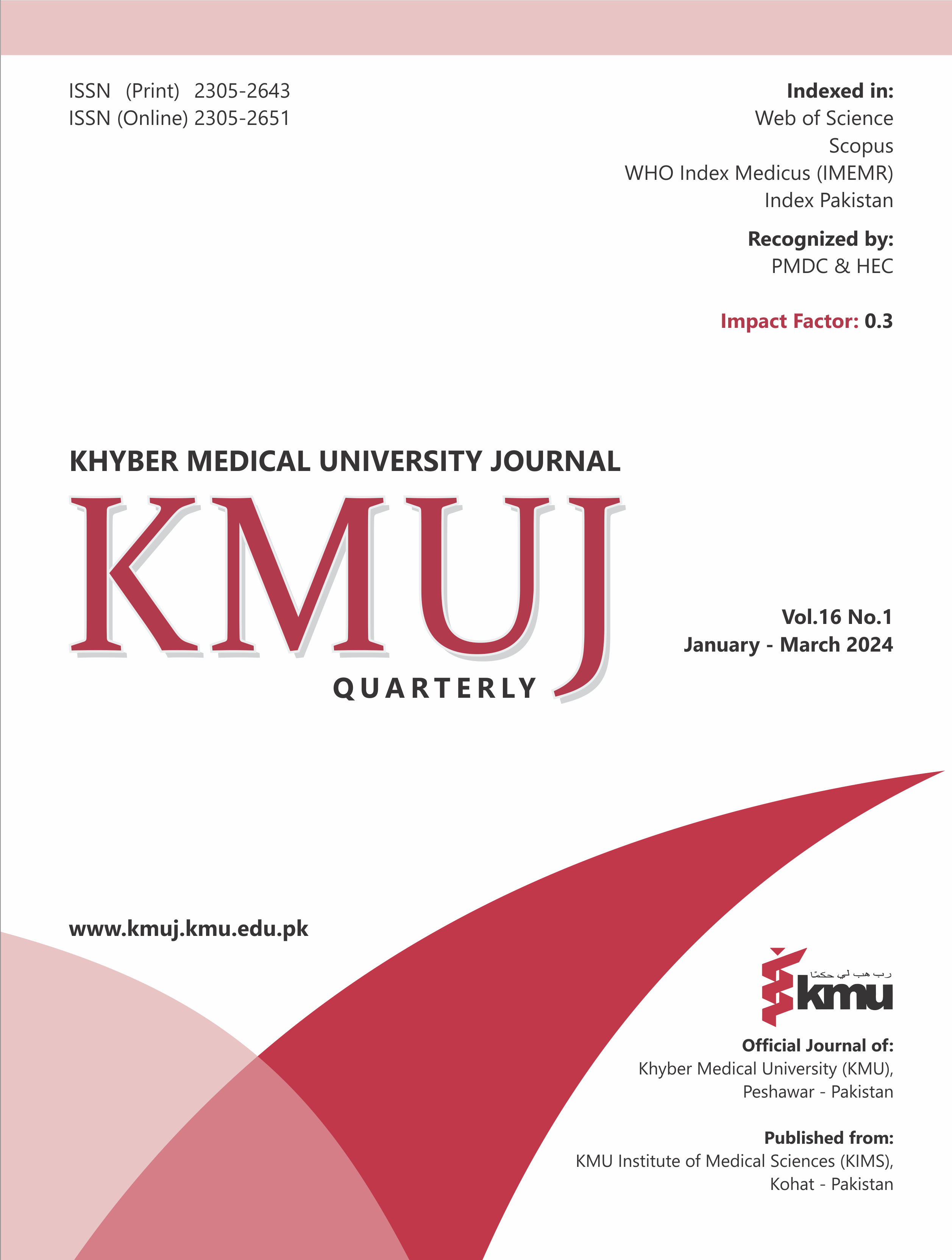Probing the underlying causes of thyrotoxicosis and its applied significance: a comprehensive evaluation
Main Article Content
Abstract
OBJECTIVE: To determine the significance of etiological basis of thyrotoxicosis in guiding optimal treatment selection and its correlation with age and the presence of goiter.
METHODS: This cross-sectional study was conducted at MTI-Hayatabad Medical Complex in Peshawar, Pakistan, from December 2022 to May 2023. Utilizing nonprobability-consecutive sampling, we enrolled 119 participants, focusing on individuals presenting with thyrotoxicosis confirmed by thyroid function tests (TFTs). Those already undergoing treatment for hyperthyroidism were also included. Essential diagnostic assessments, such as radioiodine scans, erythrocyte sedimentation rate (ESR), and thyroid receptor stimulating antibody tests, were performed as needed. Patients with chronic renal disease, chronic liver disease, and pregnant and lactating women were excluded.
RESULTS: The mean age of participants was 40.39±13.65 years, with 84.03% having TSH <0.1 mIU/L. Elevated ESR (74.17±33.62 mm/1st hour) was noted in thyroiditis. Females constituted 72.3%. Overt hyperthyroidism (51.3%) and Graves’ disease (50.4%) were prevalent. Inappropriately treated cases were 19.3%. Graves’ disease patients with Thyroid receptor stimulating antibodies showed 88% positivity. Treatment modalities included anti-thyroid drugs (43.7%), radioactive iodine therapy (28.6%), conservative (12.6%), and surgery (10.1%). Thyroid dysfunction was most prevalent in the age range of 31-40 years (32.7%). Goiter was absent in 44.5% of participants. Notably, 17.6% had apathetic hyperthyroidism.
CONCLUSION: This research emphasizes the vital understanding of thyroid dysfunctions in Pakistan, revealing Graves' disease as the primary cause of overt hyperthyroidism. Females, particularly aged 31-40, exhibit higher susceptibility. Emphasizing the importance of accurate diagnosis, this study highlights the prevalence of inappropriate prior treatments in thyrotoxicosis cases.
Article Details

This work is licensed under a Creative Commons Attribution 4.0 International License.
Work published in KMUJ is licensed under a
Creative Commons Attribution 4.0 License
Authors are permitted and encouraged to post their work online (e.g., in institutional repositories or on their website) prior to and during the submission process, as it can lead to productive exchanges, as well as earlier and greater citation of published work.
(e.g., in institutional repositories or on their website) prior to and during the submission process, as it can lead to productive exchanges, as well as earlier and greater citation of published work.
References
Madariaga AG, Palacios SS, Guillén-Grima F, Galofré JC. The incidence and prevalence of thyroid dysfunction in Europe: a meta-analysis. J Clin Endocrinol Metab 2014;99(3):923-31. https://doi.org/10.1210/jc.2013-2409
Taylor PN, Albrecht D, Scholz A, Gutierrez-Buey G, Lazarus JH, Dayan CM, Okosieme OE. Global epidemiology of hyperthyroidism and hypothyroidism. Nat Rev Endocrinol 2018;14(5):301-16. https://doi.org/10.1038/nrendo.2018.18
Zhang X, Wang X, Hu H, Qu H, Xu Y, Li Q. Prevalence and Trends of Thyroid Disease Among Adults, 1999-2018. Endocr Pract 2023;29(11):875-80. https://doi.org/10.1016/j.eprac.2023.08.006
Yadav NK, Thanpari C, Shrewastwa MK, Sathian B, Mittal RK. Socio demographic wise risk assessment of thyroid function abnormalities in far western region of Nepal: A hospital based descriptive study. Asian Pac J Trop Dis 2013;3(2):150-4. https://doi.org/10.1016/S2222-1808(13)60060-2
Azeez TA, Adetunji TA, Adio M. Thyrotoxicosis in Africa: a systematic review and meta-analysis of the clinical presentation. Egypt J Intern Med 2022;34:57. https://doi.org/10.1186/s43162-022-00145-5.
Reid JR, Wheeler SF. Hyperthyroidism: Diagnosis and treatment. Am Fam Physician 2005;72(4):623-30.
Subbiah K, Kumar J, Sivappriyan S, Anandappa S. Differentiating recurrent thyroiditis from Graves’ disease on a background of lithium use. J Endocr Soc 2021;5(Suppl 1):A927. https://doi.org/10.1210%2Fjendso%2Fbvab048.1894
Karndumri K, Thewjitcharoen Y, Chatchomchuan W, Porramatikul S, Krittiyawong S, Wanothayaroj E, et al. Impact of first-line treatment choice on long-term outcomes of hyperthyroid graves’ disease patients with thyrotoxic periodic paralysis. J Clin Transl Endrocr 2020;21:100235. https://doi.org/10.1016/j.jcte.2020.100235
Bhattarai AM, Pandeya D, Parajuli S, Pradhananga S. Pattern of thyroid illness in a tertiary hospital in Nepal. Med J Shree Birendra Hosp 2020;21(1):93-7. https://doi.org/10.3126/mjsbh.v21i1.39366
Ullah F, Ali SS, Tahir H. Clinical spectrum of thyroid disorders; An experience at a tertiary care hospital in Peshawar. Pak J Med Res 2022;61(2):56-62.
Alam Z, Shah M, Khan M, Ali W, Shehzad A, Shah JA, et al. Thyroid dysfunction and prevalence of both clinical and subclinical forms of hyperthyroidism and hypothyroidism in District Mardan, KPK, Pakistan. Bull Env Pharmacol Life Sci 2019;8(11):98-104.
Leo SD, Lee SY, Braverman LE. Hyperthyroidism. The Lancet 2016;388(10047):906-18. https://doi.org/10.1016/S0140-6736(16)00278-6
Pooria A, Pourya A, Gheini A. Frequency of pathological types of hyperthyroidism in thyroid scan patients. Curr Med Imaging 2021;17(5):608-12. https://doi.org/10.2174/1573405616666201118142752
Kuzmanovska S, Vaskova O. Interference in thyroid function immunoassays: Clinical consequences. Maced Pharm Bull 2020;66(1)73-8. https://doi.org/10.33320/maced.pharm.bull.2020.66.01.008
Abraham P, Avenell A, Park CM, Watson WA, Bevan JS. A systematic review of drug therapy for graves' hyperthyroidism. Eur J Endocr 2005;153(4):489-98. https://doi.org/10.1530/eje.1.01993
Kravets I. Hyperthyroidism: diagnosis and treatment. Am Fam Physician 2016;93(5):363-70.
Ahn HY, Cho SW, Lee MY, Park YJ, Koo BS, Chang HS, et al. Prevalence, Treatment Status, and Comorbidities of Hyperthyroidism in Korea from 2003 to 2018: A Nationwide Population Study. Endocrinol Metab (Seoul) 2023;38(4):436-44. https://doi.org/10.3803/EnM.2023.1684
Akhter S, Khan A, Siddiqui MM, Nawab G. Frequencies of thyroid problems in different ages, sex and seasons. J Med Sci 2001;1:153-6. https://doi.org/10.1186/s12884-018-2059-8
Weihua W, Zhenjie S, Jiangpo Y, Qinghui M, Mingli W, Jiajing M. A clinical retrospective analysis of factors associated with apathetic hyperthyroidism. Pathobiology 2010;77(1):46-51. https://doi.org/10.1159/000272954
Iqbal MA, Naseem Z, Qureshy A, Shahid A, Roohi N. Prevalence and manifestations of thyroidal dysfunction in Central Punjab Pakistan (a case study). Sci Int (Lahore) 2016;28(4):3959-63.
